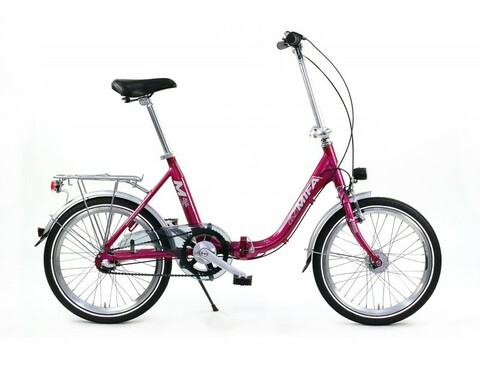If you are a vintage folding bike lover looking to purchase and restore a vintage bicycle or already own one but have yet to identify it, this article is perfect for you.
Today I will share some folding bike history and present over fifty vintage bicycle brands, with descriptions and images of each bicycle.
I have an old vintage folding bike. Can you identify who made it and when?
Email us some good photographs of your bike, and we can usually identify it. Sometimes we get stumped, typically with bikes that have been repainted or significantly modified.
In the case of foreign bikes, you can do some sleuthing on Google by knowing the foreign language term for “folding bike,” or please refer to the folding bicycle translations below:
- Folding bike (English)
- Vélo pliant (French)
- Klapprad (German)
- Bicicleta plegable (Spanish)
- Bicicleta dobrável (Portuguese)
- Bicicletta pieghevole (Italian)
- Sepeda lipat (Indonesian)
- Hopfällbar cykel (Swedish)
- Vouwfiets (Dutch)
- Rower składany (Polish)
- Складной велосипед (Russian)
- 折叠自行车 (Chinese)
If you have what you may think is an exciting or historic folding bike, it could end up in our Photo Gallery!
How much is my vintage folding bike worth?
There needs to be a robust market for buying used folding bikes, so it isn’t easy to put a definitive price on one. It may have significant value if rare or unusual, but the condition is everything.
Email us some high-quality photos if you come across what you think may be a valuable folding bike, and we’ll give you a value price range based on the auction and private sale data.
The follow-up to this question is, where can I sell my vintage folding bike?
eBay is an excellent place to give it maximum exposure to a global audience of buyers. You also might post to the folding bike subsection of Bike Forums; collectors and other interested parties frequent there.
While it may sound glib, the ultimate answer to what it is worth is – it’s worth whatever someone else is willing to pay for it!
52 Vintage Folding Bikes (That We Love)!
Listed below, in alphabetical order, is our historical record of over fifty vintage bicycle brands that we have ridden, discovered, or kindly been informed by our readers about.
1. ADAC Winora Folding Star
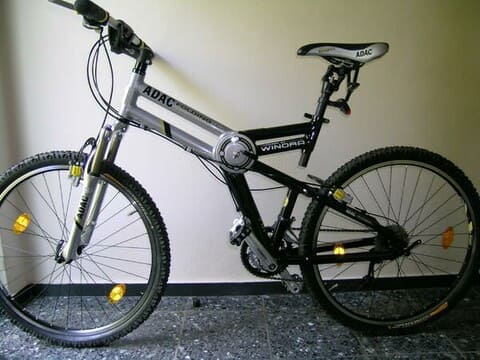
The ADAC (Allgemeiner Deutscher Automobil-Club) commissioned Winora, a well-known German bicycle manufacturer, to make this folding mountain bike part of a collection of bicycles they sold to the German public. The ADAC is the German equivalent of the AAA (Automobile Club of America).
The bike is interesting because it folds under via a circular rotating hinge mechanism. The bike was sold from 2002 until 2004 for 1,699 €.
2. Auto-Mini Folding Bike
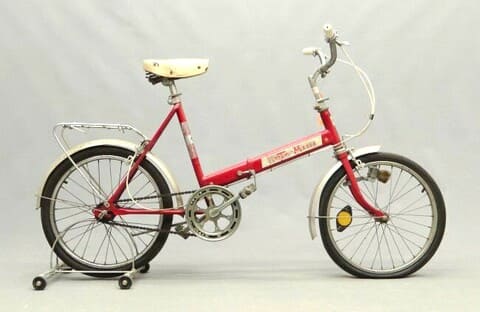
The Auto-Mini was a folding bike made by the Junior Fahrradwerke in Graz and Köflach, Austria, from 1965/66 to 1975.
The bicycle was primarily made for department stores and mail order companies which carried their respective name on the head badge decal, but it always said “Auto-Mini” in large type on the main frame tube.
There were two versions of the Auto-Mini, a “Junior” model and a larger model with a slightly longer wheelbase.
The Junior model could be distinguished by the word “Junior” appearing in the “T” of the word “Auto-Mini” in small script letters. All models had 20″ wheels and were either single-speed or equipped with a 3-speed Sturmey-Archer hub or a Fichtel & Sachs 2-speed Duomatic hub.
In the U.S., Montgomery Ward and J.C. Penney sold the bike, as did Simpsons-Sears (badged “Executive”) in Canada.
“Kent” badged examples are also common as they were a wholesale importer and distributor of the Auto-Mini in North America. Occasionally a well-known bicycle company such as Elswick Hopper in England, for example, would carry it as an OEM folding bike offering.
It isn’t a particularly rare bike as they were sold in the thousands of units but finding them in original mint condition is pretty tricky. The first four photos below are of an Auto-Mini sold by Montgomery Ward, and the last photo is of one sold by Elswick Hopper with a 3-speed Sturmey-Archer hub.
3. Beistegui Hermanos BH
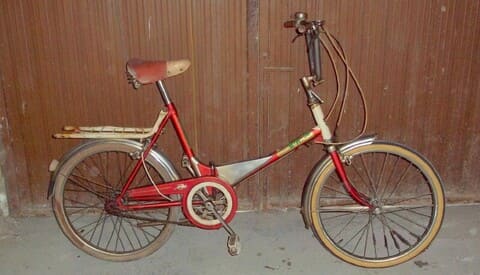
This folding bicycle was made by Beistegui Hermanos (better known as simply “BH”) circa 1974 in Vitoria, Spain.
4. BMW Folding Bike
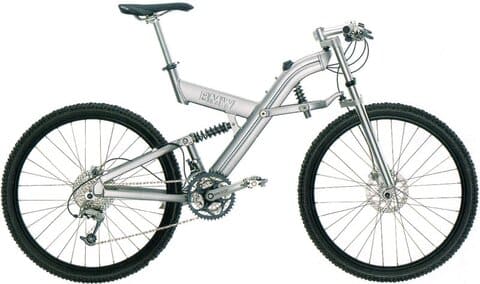
In 2000 BMW introduced its line of stylish folding bikes. While BMW had a hand in their design, Schauff, a German bicycle company, produced the bicycles.
The BMW Q6.S folding mountain bike shown below was top-of-the-line and retailed for a somewhat pricey $3995. The bike’s main innovation was a front Telelever suspension borrowed from BMW’s motorcycles.
It is worth noting that BMW folding bikes have evolved from these original models and continue to sell a range of folding and regular bicycles today.
5. Bridgestone Grandtech GR-27
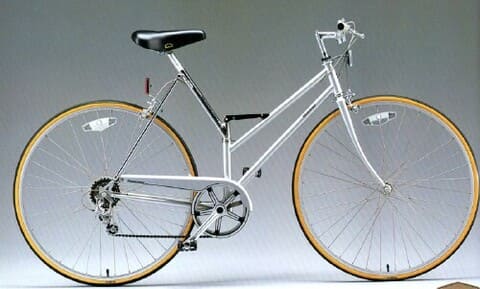
Two Bridgestone engineers, Ritsuo Nishimura and Nobuaki Shimada invented this bike and patented it in 1983. The bike won the Good Design Award in 1984 and was introduced for sale in the 1986 catalog.
Bridgestone ended its production with the 1988 model year, then brought it back virtually unchanged in 2013 as the Transit Sports G26, shown in the last two photos.
The G26 has smaller 26″ wheels, whereas the GR-27 has 700c.
6. Bridgestone Picnica (1970)
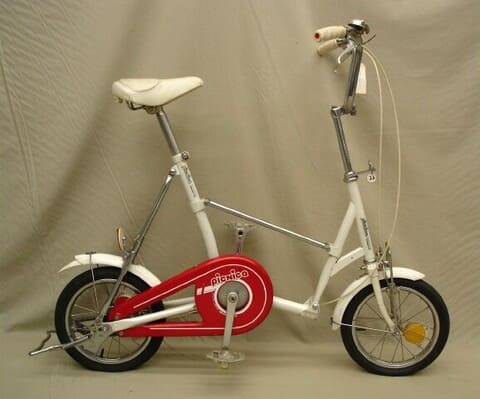
Not many details are available for this folding bike; however, it looks pretty unusual, so I wanted to include it anyway.
7. Bridgestone Transit T200CS Carbon
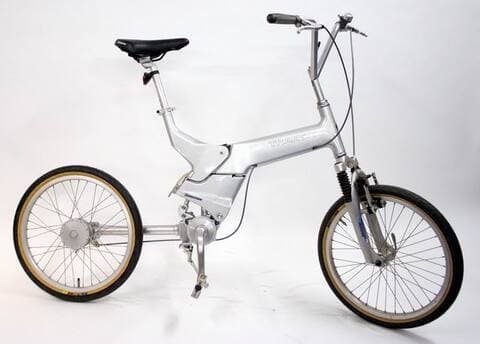
This is a unique and relatively rare Japanese folding bike. Bridgestone introduced it in 1999 and won the Good Design Award from the Japan Institute of Design Promotion. It features a single-speed cantilevered shaft drive, a carbon monocoque frame, a rear suspension, and front shock forks.
8. Caloi Berlineta from Brazil (1972)
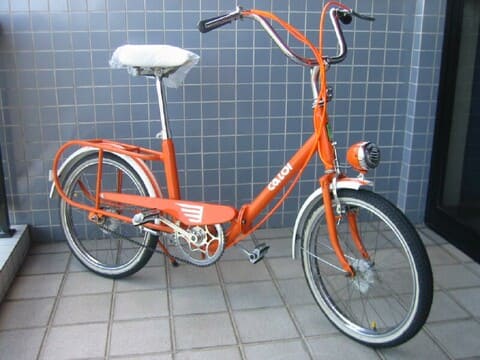
Caloi is a sizeable Brazilian bicycle company based in São Paulo, Brazil. The company was founded in 1898 by Italian immigrants Luigi Caloi and his brother-in-law, Agenor Poletti. In the 1970s, the Caloi Berlineta was a prevalent folding bike model.
9. Cannondale On Concept
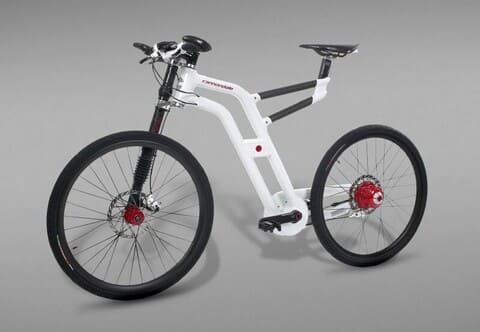
In 2007, Cannondale Bicycle introduced a concept folding bike named “On.” Unfortunately, the novel carbon fiber and aluminum bike never went into production.
10. Charles H. Clark’s Foldable Bicycle
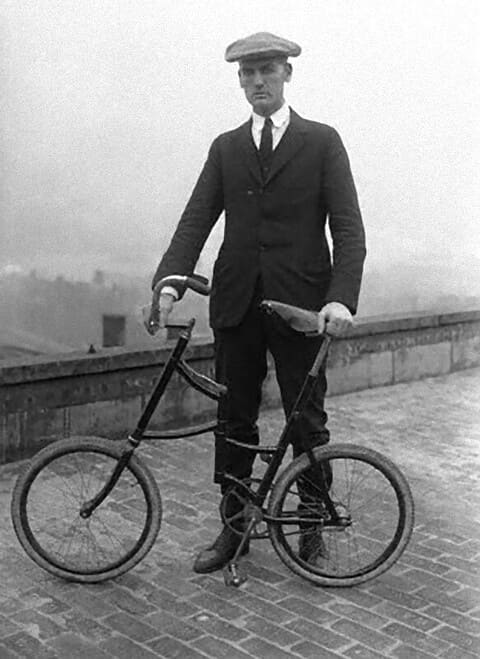
Charles Haskell Clark, of New York City, developed what may be one of the earliest small-wheeled folding bikes. He filed for a patent on his folding bicycle in 1922 and was awarded in 1926.
The bike wasn’t a commercial success, and no known examples have been found.
This folding bike is important because it may have influenced the designs of later folding bikes since Mr. Clark’s patent is referenced in patents by Dahon, Brompton, Montague, Bridgestone, Cycling Sports Group, etc.
This wasn’t Mr. Clark’s first try at bicycle design.
In 1919, he filed a patent (granted in 1921) for a portable bicycle that was “easy to carry onto trains or street cars.” While it wasn’t a folding bike, it was compact with small wheels.
While it was an exciting design, the small wheels, and the diminutive frame probably made for a bumpy and unstable ride. This may be why he evolved his thinking into a more giant-wheeled folding bike with a longer wheelbase.
11. CMK Folding Bike
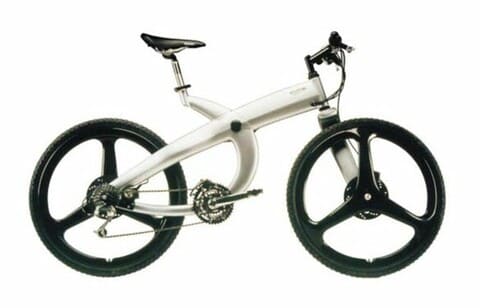
Thomas Müller, a German industrial designer, was awarded a patent on this folding bike design in 1996. He produced a prototype, but the bike never made it into commercial production. The exciting design with cantilevered wheels and a carbon fiber frame also featured folding handlebars.
12. Diamant Handy
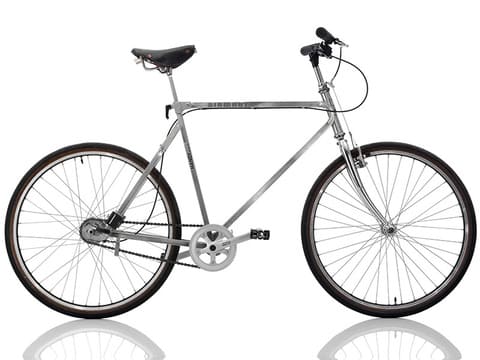
The “Handy” was a folding bike made in the early 90s by Diamant, one of the oldest bicycle manufacturers in Germany. They are no longer in business.
It was designed by John S. Strozyk, an American living in Germany, who filed for a patent on it (drawing below) in 1988. It was made of stainless steel and featured a 7-speed Shimano hub gear with a coaster brake.
13. DNB Porta-Fold Cycle (1959)
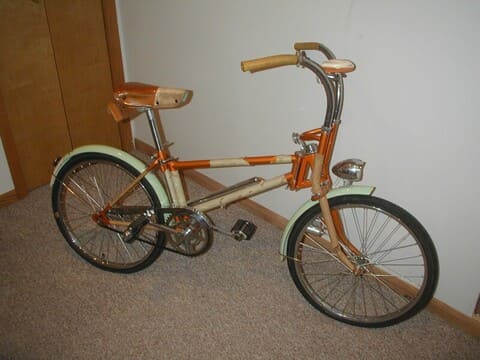
This attractive folding bike was submitted by a reader who purchased it from its second owner, who kept it in storage for years. The bicycle is in pristine condition with the original protective wrapping, which is quite remarkable for a bike over 50 years old. It features a double-fold frame; while not unique, it was unusual in its era.
The bike was made in Japan by Dai Nippon Bicycle (DNB), a Tokyo-based manufacturer of bicycles.
DNB set up a U.S. distribution company in New York City, which serviced a network of dealers. One of their ads is shown below, following the photos of the bike.
The bike was designed by Shoji Tanaka and Yoshiyuki Katori, who filed for a patent in Japan on October 30, 1957. A U.S. patent was applied for on October 22, 1958, and granted on January 2, 1962. Drawings from the patent are at the bottom.
14. “Dubike” Concept
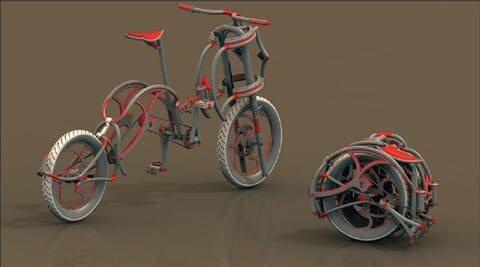
The “Dubike” is a concept folding bike created by David Fionik as a student project at the Bialystok Technical University in Poland. The design was included among the best 35 projects in the SolidWorks 2007 Design Contest. Mr. Fionik said he was influenced by the television show “Orange County Choppers” in designing this bike.
15. Duemila Italian Folding Bike
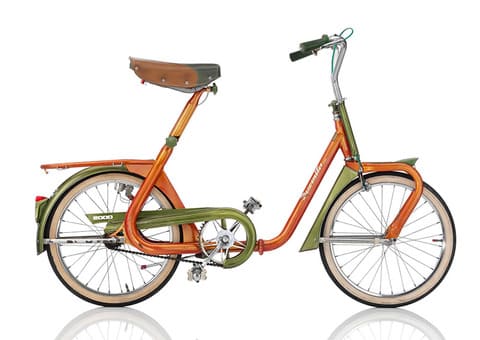
This stylish vintage Italian folding bike was called the “Duemila” or “2000” in English. It was made by Cesare Rizzato & Co. in Padua, Italy, and introduced to the public with a futuristic space theme at the Fiera di Milano trade fair in 1965.
The particular bike below is believed to be a 1968 model. The brochures below refer to the availability of a child’s model, the Duemila Minor.
The seat post and handlebars fold with the frame to make for a reasonably compact package. The bike’s price in 1965 was 38,000 lira (about $60). The bike came in two color combinations, burnt orange and green or white and green.
Cesare Rizzato went on to make other folding bikes under the “Ceriz” brand name in the 1970s.
16. Early Dutch Military Folding Bike
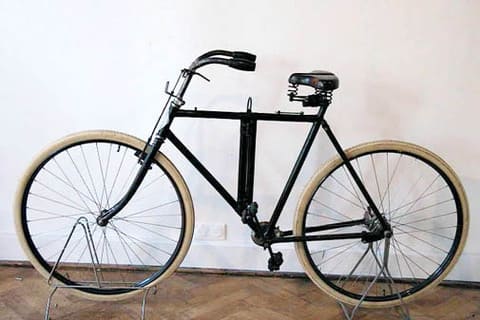
In 1899 Captain T.L. van Wagtendonk of the Dutch army invented the folding bicycle shown above for military use, which Burgers ENR manufactured.
17. Fiocchi Cometa Sprint
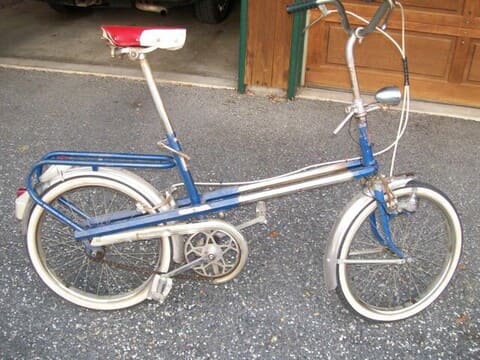
Michel Bouvier from France provided photographs of this bike. It is not technically a folding bike, but an exciting small-wheeled bicycle nonetheless. As seen in the photos, the bike frame telescopes down to a compact size. Not much is known about this bike other than it was made in Milan.
18. Fongers 1898 Military Folding Bike
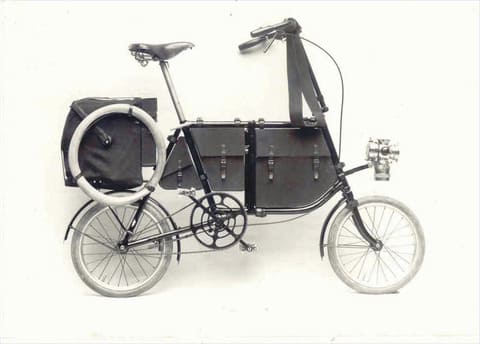
This vintage folding bicycle by Fongers, was used for military purposes and interestingly the folding bike design pre-dates some of the early patents for folding bikes.
19. Fuji Marlboro Folding Bike
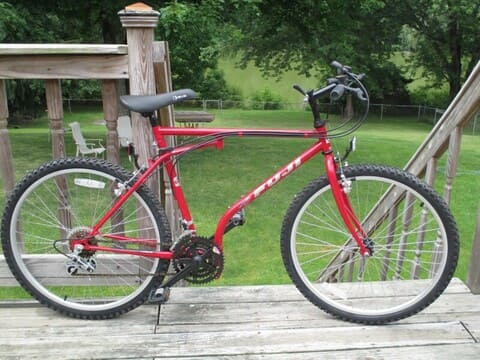
This folding bike has a whole lot of irony attached to it. Fuji made it for a Marlboro cigarette promotional campaign in 1996.
It was touted as a limited-edition (not so limited since they were produced in the thousands) folding mountain bicycle, and the name of the campaign was “Marlboro Unlimited,” with the word “Unlimited” featured on the bike’s logo decal.
20. GAC 500 Folding Bike
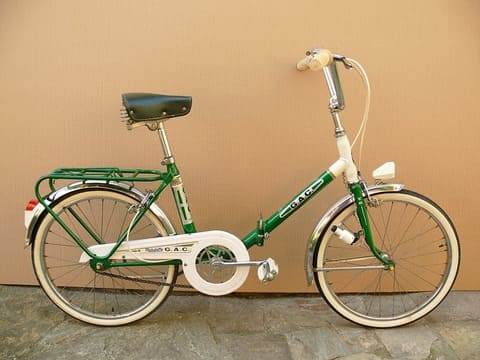
This beautifully restored late 70’s/early 80’s GAC 500 folding bike comes to us courtesy of Bicinova. G.A.C. stood for Garate, Anitua y Compañía, a now-defunct bicycle manufacturer in the Basque region of Spain.
21. Gitane-Helyett
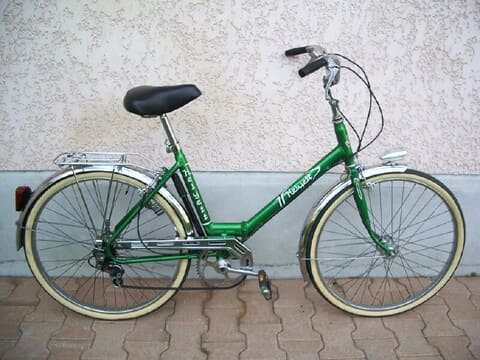
From time to time, readers send us photos of Helyett folding bikes thinking they were made by the renowned French racing bike company founded in 1919.
However, the Helyett company was sold in 1962 and sold again in 1966 to Gitane, a well-known French bicycle manufacturer.
So the folding bike you see below, from the 1970s, was made by Gitane. They also made the same model branded “Gitane.” They featured a Simplex 4-speed derailleur and 600A-size wheels.
22. Gitane Plicyclette (1960s)
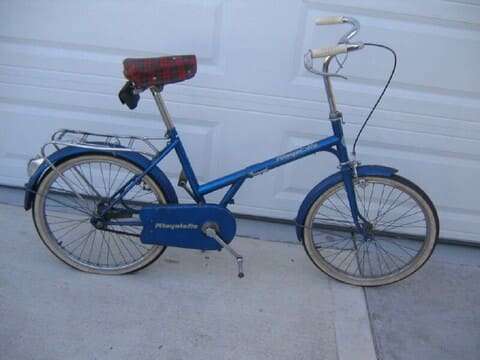
The picture above is a brochure scan of the 1966 Gitane Plicyclette. The bicycle costs $79.95 for the single-speed coaster brake version and $99.50 for the 3-speed.
23. GOLD-RAD Piccolo
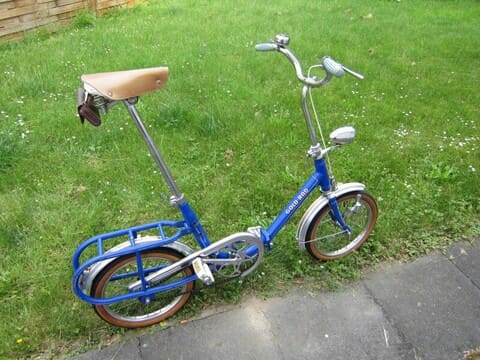
This relatively rare German folding bike is from the late 50s or early 60s GOLD-RAD Piccolo in remarkable original condition. The GOLD-RAD (Gold Wheel in English) company was founded in 1892 by Benjamin Goldberg in Siegburg, Germany.
To keep up with bicycle demand after WWI, Mr. Goldberg moved the company to Cologne and opened a modern bicycle factory in 1930.
Since economic times were tough during and after the war, GOLD-RAD was one of the first companies to allow customers to purchase a bicycle and pay with monthly installments. GOLD-RAD ceased operating in 1998.
The date of the introduction of the Piccolo folding bike is unknown, but the photo below depicts a man holding one at the “Day of the Bicycle” show in Nuremberg on March 19, 1959.
The first advertisement photo that follows was from July 1958, so it is assumed that this folding bicycle first appeared around this time.
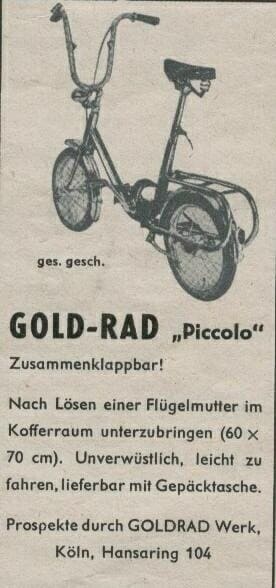
The last advertisement below is from 1965. The GOLD-RAD Piccolo was featured as a bicycle that could fit under the front hood of a Volkswagen 1200.
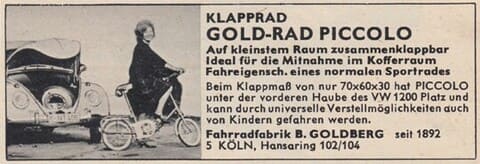
24. Graziella Folding Bike
The original bike was built as a Bottecchia brand but adopted the Graziella name by product launch in 1964. The initial Graziella was a single-speed folding bike with the following:
- 16″ wheels;
- A dynamo headlight;
- A bell to alert other vehicles of your presence; and
- A front brake and a rear coaster brake.
In 1971 a model with 20″ wheels was offered along with the original 16″ wheel version.
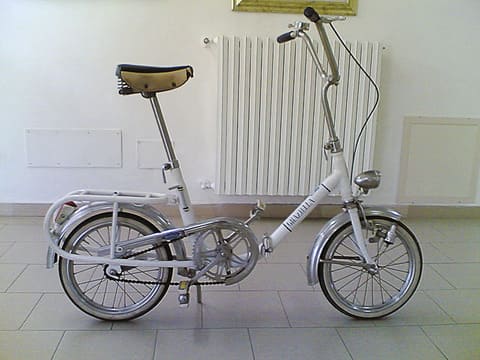
Some minor accessory modifications were introduced over the years, including changes in the headlight style, front basket, etc. Gears became available in the mid-’70s with an optional 3-speed hub gear.
A Flor or “Flower” model was released that was adorned with flower decals, apparently a nod to the hippie flower power era. In the late ’70s, a model with 22″ wheels was available.
25. Graziella Tandem Folding Bike
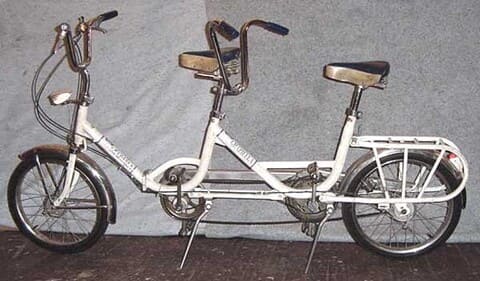
Graziella also produced a tandem folding bike around 1964, which used primarily the same design parameters (i.e., a single-speed drivetrain, 16-inch wheels, and dynamo lighting), with the apparent difference being the addition of a second saddle and set of pedals for an additional rider.
26. Hercules California
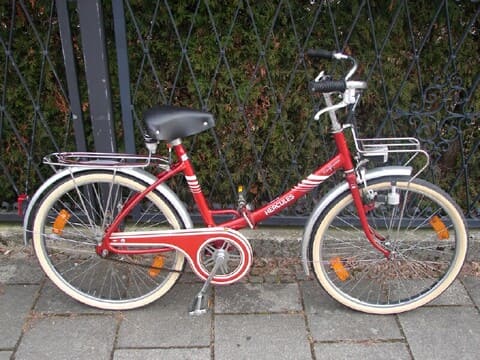
This is a mid 70’s Hercules California folding bike made in West Germany. The 24″ wheeled bicycle is in remarkable original condition, except that the more upright stock handlebars have been replaced with more cruiser-style ones. Hercules folding bikes are reasonably standard, but “California” models are somewhat rare.
27. Japanese Katakura Silk Porta-Cycle
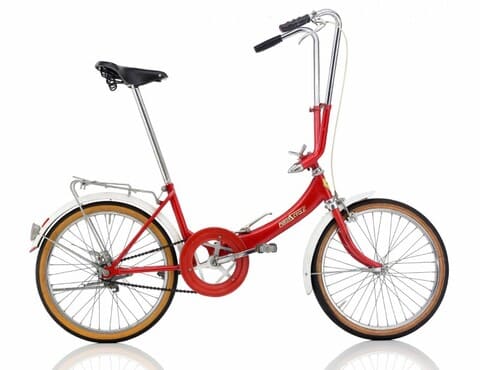
A still photo from a 1957 episode of the TV show “Sugarfoot” shows actress Jan Chaney walking a Katakura Silk Porta-Cycle folding bike.
28. Koga Miyata Founder
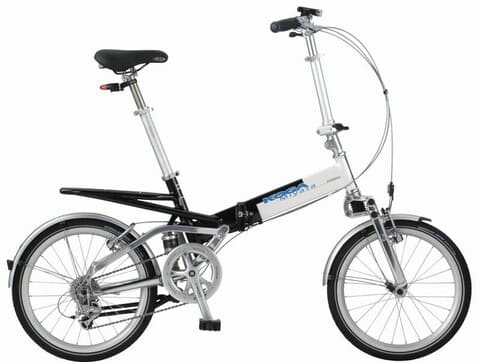
Koga, a Dutch bicycle manufacturer, began a joint venture with Miyata, a Japanese bicycle maker, in the mid-’70s to produce Koga Miyata bicycles.
The only Koga Miyata folding bike model made was the “Founder,” which was introduced in 2004, and there were two versions, the Founder S, which was a complete suspension bike, and the Founder, which only had rear suspension.
Production of the Founder ended in 2010 when the Koga-Miyata partnership was dissolved. Without Miyata, Koga produces a tandem folding bike – the TwinTraveller.
The bike above is a 2010 Founder S model with full suspension.
The rear suspension is a 20mm travel Fastrax adjustable air shock, and the front suspension is a 20mm travel Fastrax dual link. The Founder S has 9-speeds and weighs 14.3kg (31.5 lbs). MSRP was 1699.00€.
29. Koga TwinTraveller Tandem
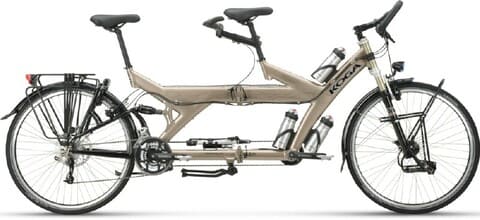
This is a Koga TwinTraveller tandem folding bike made in Holland. The TwinTraveller model was first introduced in 2000 as a non-folding bicycle, and it won “Bike of the Year” at a trade show in Amsterdam.
The folding version appeared in 2005 and was still being produced as of 2014.
It has full suspension, which is uncommon for a tandem folding bike, and features 27-speeds, a rear hydraulic disc brake, and weighs in at 29.1kg (64 lbs). The MSRP as of 2014 was $6700.
30. Motobecane Folding Bikes (the 1970s)
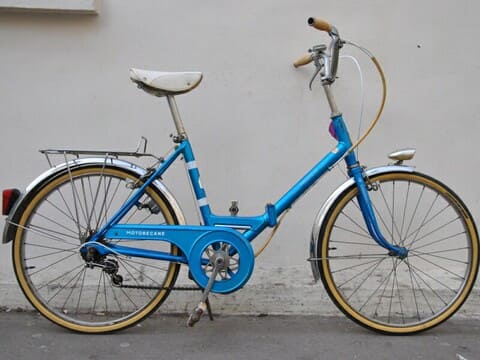
Motobecane was a famous French folding bike maker in the 1970s who also made bikes under the “Motoconfort” brand. The particular bicycles below are the “Progress” models with 24″ wheels.
They were engaging in that the Progress model came in several optional configurations, some with innovative features for the era.
You could get a 3-speed Sturmey Archer hub gear with a trigger shift, a 5-speed derailleur, or a Shimano AB-100 Automatic 2-Speed Hub that used centrifugal force to shift gears automatically.
The AB-100 had a red adjuster ring (see photos) that allowed you to set the speed at which it shifted. Some Progress models were available with hydraulic brakes, a rarity for folding bikes.
31. Meister Folding Bike
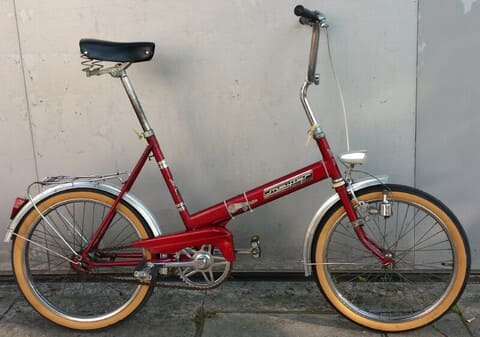
This Meister folding bike was made in West Germany in the late 60s or early 70s. It was created by Karl Goebel Fahrzeugfabrik, located in Bielefeld, where once a large bicycle manufacturing industry was located.
Goebel was a motorcycle and bicycle manufacturer and had acquired Meister Fahrradwerke, another motorcycle manufacturer, in 1959 and used their brand on this particular bike.
They also made the same model but with the “Goebel” brand.
Goebel patented the folding mechanism in 1967, but it only consisted of a simple latch and a screw catch to secure the hinge in a closed position. The bike featured a 2-speed Fichtel & Sachs Torpedo Duomatic hub gear.
32. Mercedes-Benz Folding Mountain & Street Bike
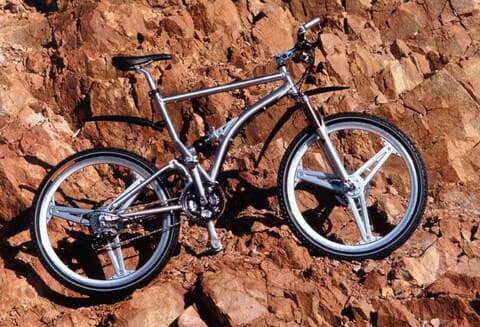
In 2001, Mercedes-Benz introduced a folding mountain bike and a version more oriented towards street riding (last photo); both had rear and front suspension.
They used what Mercedes called the CAR.RY System.
This system was comprised of two connectors, one on the downtube that allowed the rear wheel to be folded forward and the second in the handlebars, which allowed them to fold down. The front wheel was then removed utilizing a quick-release mechanism.
Once folded, they claimed the bike could even fit into their smaller C-Class Sports coupés.
A nylon carrying case was included. The wheels on the mountain bike version, made by Protos, cleverly mimicked the Mercedes logo. Like most things Mercedes, the price was steep – 3200€.
33. Microbike Folding Bike from Sweden
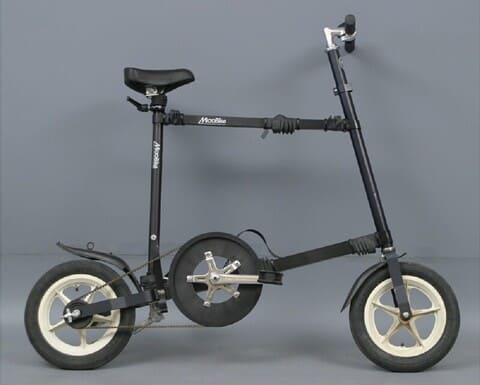
The MicroBike folding bike was designed and made in Sweden by Otto Linander and Sven Hellestam in 1987; it is no longer in production.
The above example is a 1993 model. It had 12″ plastic wheels and an aluminum frame weighing 18.7 pounds (8.5 kg) and featured a Kevlar belt drive.
34. MIFA Folding Bikes
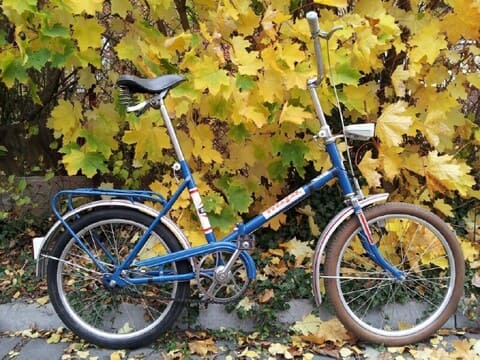
The MIFA folding bicycle is historically significant in that almost 3 million were produced between 1967 and 1990.
MIFA, an acronym for Mitteldeutsche Fahrradwerke AG, was founded in 1907 in Sangerhausen, Germany, and became the largest bicycle manufacturer in the DDR (East Germany) after WWII.
They introduced their first folding bike to the market in 1967 with the Model 901.
Subsequent models were the 903 and a deluxe version of the 903, the 904, both introduced in 1976. In 1978 alone, 1.5 million 903 and 904 models were produced.
MIFA continues to make folding bikes to this day, possibly granting them the honor of being the longest-continuous manufacturer of folding bicycles in history.
35. Mitutoyo Bicycle
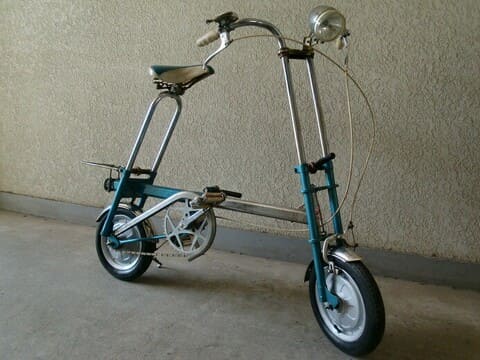
This is a rather unusual and relatively rare bike. The seat, handlebars, and top tube all telescope down to make a relatively compact portable bike. Mitutoyo probably didn’t make the bike though their name and logo are on it.
Mitutoyo is a well-known maker of precision measuring instruments based in Japan.
They likely contracted this bike to be made as a promotional gift for the dealers of their measuring products. Since the company’s old logo is used on the bike, this would date to the late 60s or early 70s.
36. Neckermann Folding Bike
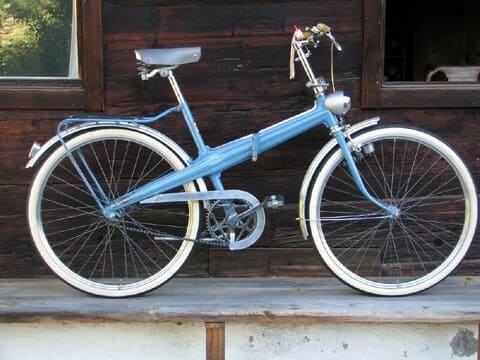
This relatively rare folding bike comes to us courtesy of Thomas at Authentic Vintage Bicycles, who performed a remarkable restoration on this 1962 Neckermann, keeping it as original as possible.
Geier-Werke made it in Lengerich, a city in Westphalia, Germany.
The company produced these bikes from 1961 to 1967 but went bankrupt in 1968 and is no longer in business. These folding bikes were sold via mail order from the Neckermann catalog, a page of which from 1964 can be seen below, showing a man stowing it in a Mercedes-Benz trunk (kofferraum).
More photos and the story of its technical details and restoration can be found here (in German).
37. Novara FlyBy Folding Bike
The Novara FlyBy folding bike was available up until around 2015. It was by all accounts a well-specced foldable bicycle featuring 20-inch wheels, Schwalbe Citizen tires, a 7-speed Shimano Nexus internal gearing drivetrain, an aluminum frame, and some Tern components.
In May 2009, there was a recall of Novara (and Dahon) folding bicycles due to some owners experiencing cracking of the handlebar hinge.
38. Panasonic Traincle
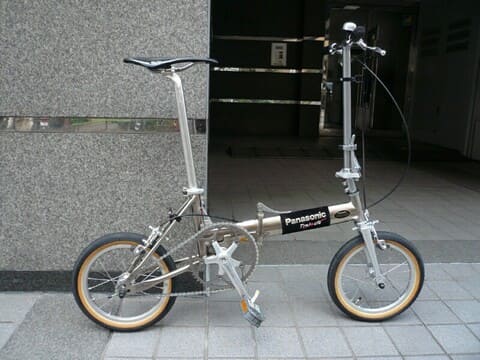
The Panasonic Traincle folding bike was initially conceived by JR-East, a Japanese train company, in 1997. Their idea, similar to the Jango Flik bike, was to offer a bicycle that commuters and tourists could use in conjunction with their travels by train.
They produced a prototype and approached National Bicycle (a subsidiary of Matsushita, now Panasonic) to manufacture it.
Panasonic made the Traincle a single-speed with a titanium frame and 12″ wheels and introduced two bike models (6500 & 7500) in 1998 at the Tokyo International Cycle Show.
It won a “Good Design Award” from the Japan Institute of Design Promotion in 1999.
The Traincle was a reasonably light bike made from titanium, weighed 6.5kg (14.3lbs), and was touted as the most lightweight folding bike on the market. It was a rather expensive bike, though, around $2000 at introduction.
The Traincle was sold until 2014 before being discontinued, most likely because the price had risen to about $3200.
39. Peugeot Helium
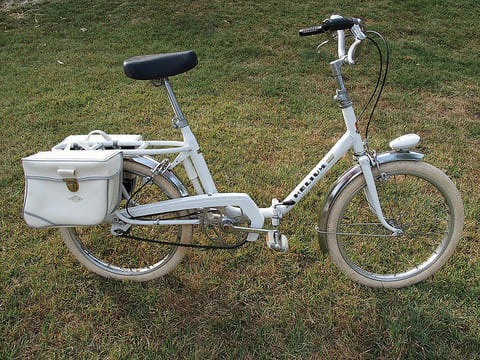
This is a Helium folding bike from the early 70s made by Peugeot. Peugeot used the “Helium” branding for their lower-end, less expensive bicycles. The one is in exceptional original condition.
40. Russian Leitner Military Folding Bike
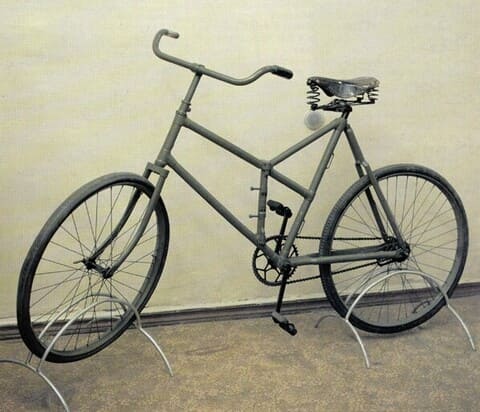
Above is a photo of a Leitner (or Leutner) military folding bike c. 1914. It was designed and built by Alexander Leutner in Riga, Latvia. While it is commonly known as a “Russian” bike, the association is not so much of the country.
Instead, the brand name used by Leutner on his bicycles was “Russia” (“Россiя” in pre-1918 Cyrillic, it would read “Россия” in modern Cyrillic).
Another confusion is Alexander’s last name.
The Romanization from Cyrillic yields “Leitner” rather than the actual “Leutner,” a surname of German descent. After graduating high school in the early 1880s, Alexander Leutner (shown below) apprenticed as a mechanic in Riga.
He then went to France to further his education and ended up in Lyon, where he toured a bicycle factory which sparked his interest. He then went to Coventry, England, and Aachen, Germany, to study bicycle mechanics.
In the late 1880’s he returned to Riga and opened a bicycle workshop.
His bicycle business expanded rapidly to become the largest bicycle factory in the Russian Empire. It was the start of a vast enterprise that ultimately built motorcycles, cars, boats, and armaments.
The Russian military commissioned Leutner to make a folding bike for military use after they had initially tested the French Captain Gerard folding bike (see main Folding Bike History page) and found it lacking.
The Russian army generals also found it troublesome to procure bikes from a foreign power.
During WWI, Leutner’s factory was relocated to Ukraine to keep it from falling into German hands. His folding bike design was built in other factories later under the “Dux” name, specifically the “Dux-Battle” military model.
A stamp was issued by Russia in 2008 commemorating the Leutner military folding bike. It was found to be of significant enough historical importance to merit a stamp.
41. Russian MMB3 Folding Bike
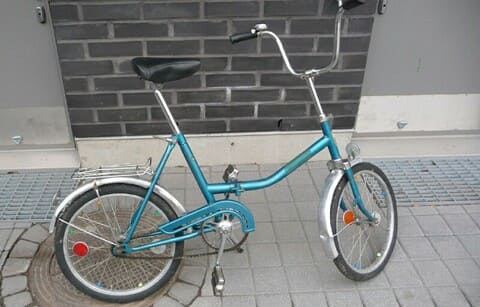
This folding bicycle was made in Belarus by Minsk Motovelo Zavod and exported to Russia.
42. Sachs Tango
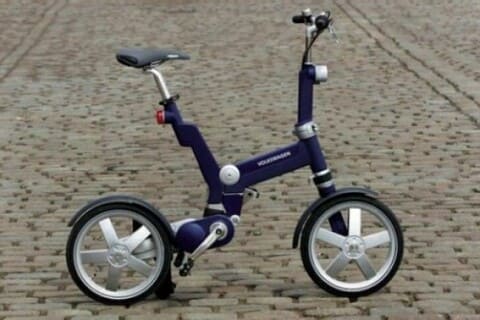
In 1997, Springtime, a Dutch design firm, created a folding bike prototype called the “Tango” and entered it into the European Bicycle Design Contest – Visions 2000 held in Milan. A jury of cycling journalists across Europe chose the Tango as the winner.
A company was formed, Urban Solutions BV, to manufacture the bicycle, but repeated production delays led to the company filing for bankruptcy.
In 2001, improvements were made to the original prototype, and Sachs, a German company, took over production and introduced it to the market under their brand. Around 2002, Volkswagen took over production and sold it under their brand as a “Tango Car Bicycle.”
Despite its innovative design, the relatively high price ($1300) and heavyweight (45lbs) resulted in poor sales, and production ceased.
The Tango featured a polyurethane-coated frame, front, and rear elastomer suspension, 16″ cast aluminum wheels, a Shimano Nexus 4-speed gear hub, drum brakes, integrated lighting, and folding pedals.
43. Sapper Zoom Bike
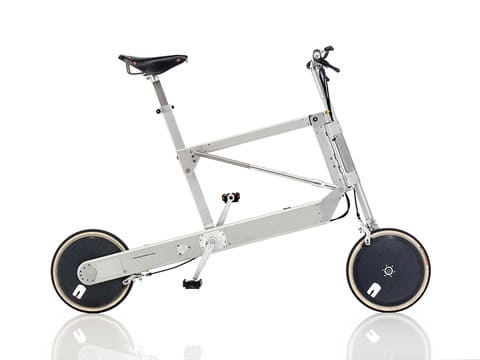
The Zoom Bike was a folding bike by German industrial designer Richard Sapper. The cycle was introduced to the public at the 1998 Frankfurt Auto Show. Elettromontaggi, an Italian company, built sixty bike prototypes but never went into commercial production.
44. Schwinn Run A Bout
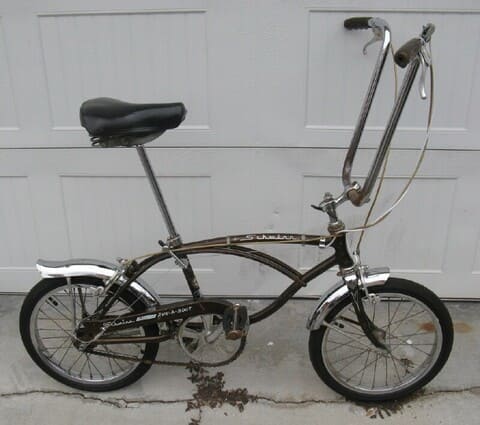
The Schwinn Run-A-Bout was technically not a folding bike since the frame itself did not fold in any way, but we included a page on it after getting countless e-mails regarding its omission.
For this bike, Schwinn took a Stingray frame, added tool-less releases to the handlebars and seat post, used 16″ wheels instead of the 20″, and called it a Run-A-Bout.
The only folding part was the handlebars which folded down then the extra-long seat post retracted into the frame making for a more compact bike that would easily fit into a car trunk. When Schwinn introduced the bike in 1968, they didn’t use the term “folding bicycle.”
Instead, they used “fold-up bikes.”
However, in 1969 they used both words to describe the bike, but by 1970, the last year of production, the “folding bicycle” moniker had disappeared. Few people still call it the “Run-A-Bout folding bike,” but Schwinn can be blamed for the confusion.
45. Sheldon Brown’s Raleigh Twenty
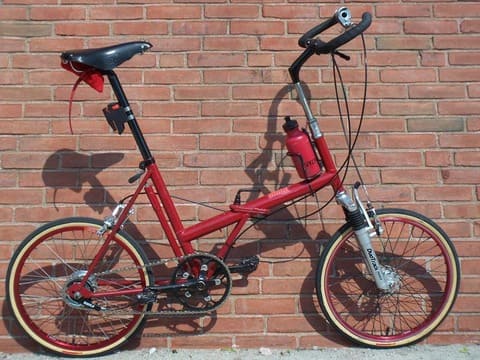
This inclusion is The Folding Bike Guy’s homage to the late Sheldon Brown, a bicycle community legend. This is a photo of his heavily modified Raleigh Twenty folding bike.
46. Silk Bicycle Factory PR-7
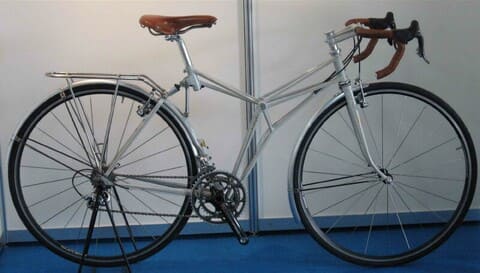
Tadashi Arai of the Silk Bicycle Factory designed this unique folding bike for the 2007 Handmade Bicycle Fair in Tokyo, Japan. It is reminiscent of a Moulton, but this bike has larger 700c wheels.
47. Soma Ti Journey
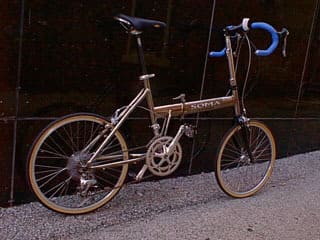
The Soma Ti Journey folding bike featured a titanium frame built by Panasonic. Soma Fabrications sold the bike from 2001 to 2003. It could be ordered as a frame only for $1600 or made as a road bike, as shown above, for $2800. Given the price, these are relatively rare bikes.
48. Strutt Worksong
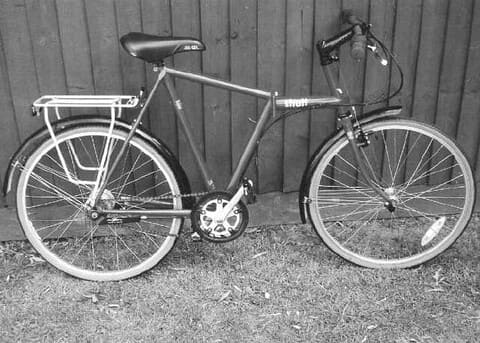
Invented by Mike Strutt, the Strutt Worksong folding bicycle is relatively rare since they were all handmade in England in small batches. The earliest model, the Mk. 1, had a more elaborate frame with more supporting tubes.
While the bike was a full-size folder, it did use smaller 24″ wheels. The attached article is from the 1993/94 issue of “Encyclopedia.”
49. Trek F400 Navigator
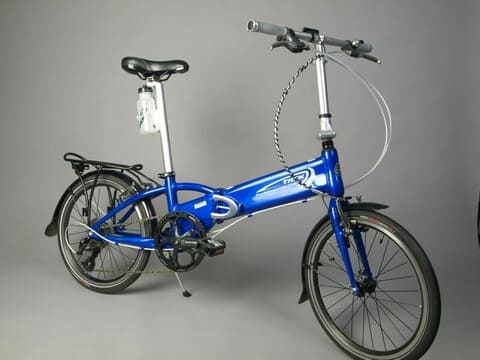
Trek made the F-series Navigator folding bicycles from 2004 to 2006; models included the F600, F400, and F100.
50. Viscount Spacemaster
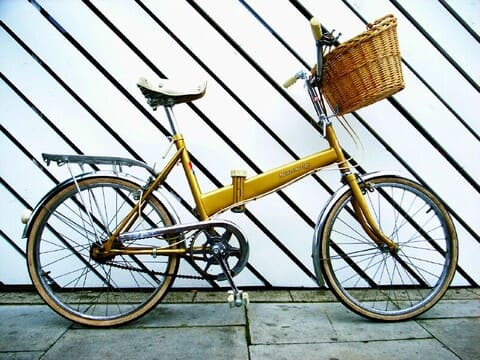
The folding bike above is a 1975 Viscount Spacemaster. The “Spacemaster” name was initially used on a predecessor bicycle by Trusty Manufacturing of England, introduced in 1965 as a “Trusty Spacemaster,” but it was a non-folding, separable bike.
Trusty Manufacturing started as a maker of children’s bicycles in the early 60s.
After acquiring Lambert Cycles in the early 70s, Trusty started using the Viscount brand on their bicycles, including standard-type bikes previously branded “Lambert.” It is still being determined when the Viscount Spacemaster was introduced or what year the production ended.
Since a patent was filed on the bike on July 22, 1975, it’s safe to assume that the first year of production was 1975.
The hinge on this bike is unusual and relatively different from other folding bikes, consisting of a spring-loaded cylindrical screw clamp to secure it in the closed position. The photos below and the drawing from the patent application illustrate the hinge mechanism.
The bike featured 20″ wheels, front and rear side pull brakes, and a 3-speed Sturmey-Archer hub gear with a trigger shift. The basket shown was not standard.
51. Wiel Transformer
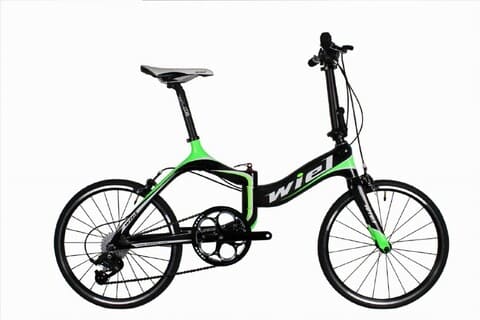
This attractive Wiel Transformer folding bike was introduced at the 2013 China International Bicycle & Motor Fair in Shanghai, where it won a Gold Award for Creative Product.
The monocoque frame is constructed entirely from Toray T700 carbon fiber.
The seat post, handle post stem, and handlebars are also carbon fiber. It features 20″ wheels, a 7-speed cassette with trigger shift, and Tektro side pull brakes and weighs in at a reasonably light 8.5kg (18.7 lbs) without pedals.
52. ZGL Mantis
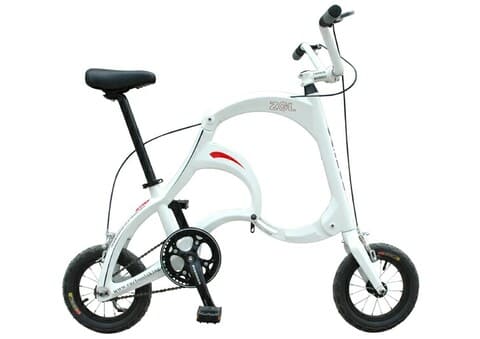
This rather unusual bicycle is a ZGL Mantis folding bike. ZGL is the brand of the Lianyungang Eagle Carbon Fiber Bike Company, a Chinese company that, as the name implies, specializes in carbon fiber bicycles.
It has 12″ wheels, single-speed, front and rear V-brakes, and folding pedals, and since it features a carbon fiber frame, it weighs in at a reasonably light 6.8kg (15lbs). Introduced in 2013, it wasn’t a big success since it disappeared from the company’s catalog reasonably quickly.

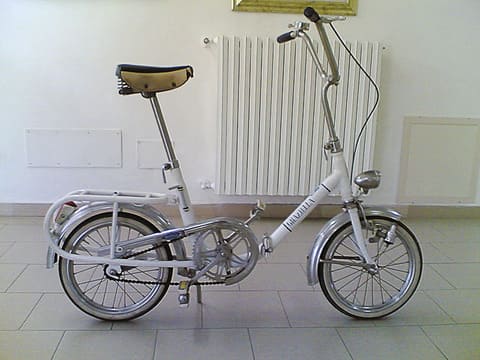
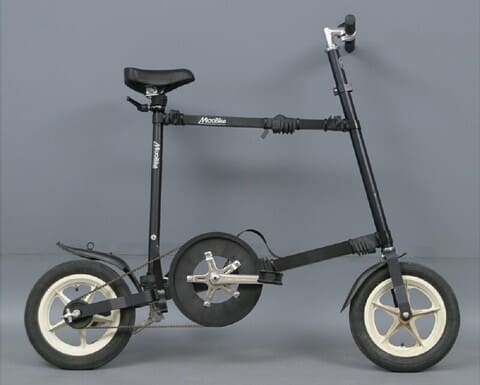
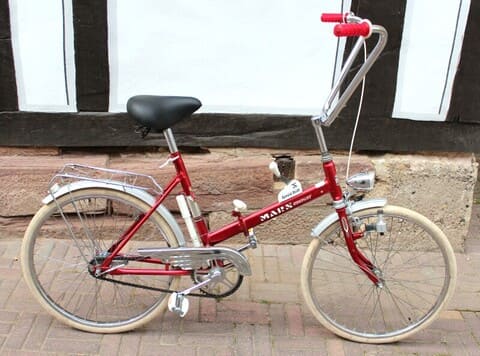
![Auto Mini Folding Bike Review [Year]](https://www.foldingbikeguy.com/wp-content/uploads/Auto-Mini-Folding-Bicycle.jpg)
